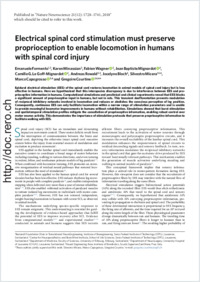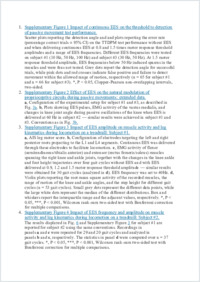Electrical spinal cord stimulation must preserve proprioception to enable locomotion in humans with spinal cord injury
- Formento, Emanuele Bertarelli Foundation Chair in Translational NeuroEngineering, Institute of Bioengineering, Swiss Federal Institute of Technology (EPFL), Lausanne, Switzerland - Center for Neuroprosthetics and Brain Mind Institute, School of Life Sciences, Swiss Federal Institute of Technology (EPFL), Lausanne, Switzerland
- Minassian, Karen Center for Neuroprosthetics and Brain Mind Institute, School of Life Sciences, Swiss Federal Institute of Technology (EPFL), Lausanne, Switzerland
- Wagner, Fabien Center for Neuroprosthetics and Brain Mind Institute, School of Life Sciences, Swiss Federal Institute of Technology (EPFL), Lausanne, Switzerland
- Mignardot, Jean Baptiste Center for Neuroprosthetics and Brain Mind Institute, School of Life Sciences, Swiss Federal Institute of Technology (EPFL), Lausanne, Switzerland
- Le Goff-Mignardot, Camille G. Center for Neuroprosthetics and Brain Mind Institute, School of Life Sciences, Swiss Federal Institute of Technology (EPFL), Lausanne, Switzerland
- Rowald, Andreas Center for Neuroprosthetics and Brain Mind Institute, School of Life Sciences, Swiss Federal Institute of Technology (EPFL), Lausanne, Switzerland - Department of Medicine, Faculty of Sciences, University of Fribourg, Fribourg, Switzerland
- Bloch, Jocelyne Department of Neurosurgery, University Hospital of Lausanne (CHUV), Lausanne, Switzerland
- Micera, Silvestro Bertarelli Foundation Chair in Translational NeuroEngineering, Institute of Bioengineering, Swiss Federal Institute of Technology (EPFL), Lausanne, Switzerland - Neural Engineering Area, Institute of Biorobotics, Scuola Superiore Sant’Anna, Pisa, Italy
- Capogrosso, Marco Department of Medicine, Faculty of Sciences, University of Fribourg, Fribourg, Switzerland
- Courtine, Gregoire Center for Neuroprosthetics and Brain Mind Institute, School of Life Sciences, Swiss Federal Institute of Technology (EPFL), Lausanne, Switzerland - Department of Neurosurgery, University Hospital of Lausanne (CHUV), Lausanne, Switzerland
-
31.10.2018
Published in:
- Nature Neuroscience. - 2018, vol. 21, no. 12, p. 1728–1741
English
Epidural electrical stimulation (EES) of the spinal cord restores locomotion in animal models of spinal cord injury but is less effective in humans. Here we hypothesized that this interspecies discrepancy is due to interference between EES and proprioceptive information in humans. Computational simulations and preclinical and clinical experiments reveal that EES blocks a significant amount of proprioceptive input in humans, but not in rats. This transient deafferentation prevents modulation of reciprocal inhibitory networks involved in locomotion and reduces or abolishes the conscious perception of leg position. Consequently, continuous EES can only facilitate locomotion within a narrow range of stimulation parameters and is unable to provide meaningful locomotor improvements in humans without rehabilitation. Simulations showed that burst stimulation and spatiotemporal stimulation profiles mitigate the cancellation of proprioceptive information, enabling robust control over motor neuron activity. This demonstrates the importance of stimulation protocols that preserve proprioceptive information to facilitate walking with EES.
- Faculty
- Faculté des sciences et de médecine
- Department
- Département de Médecine
- Language
-
- English
- Classification
- Biological sciences
- License
- License undefined
- Identifiers
-
- RERO DOC 323840
- DOI 10.1038/s41593-018-0262-6
- Persistent URL
- https://folia.unifr.ch/unifr/documents/307220
Other files
Statistics
Document views: 88
File downloads:
- cap_esc.pdf: 192
- cap_esc_sm.pdf: 114

